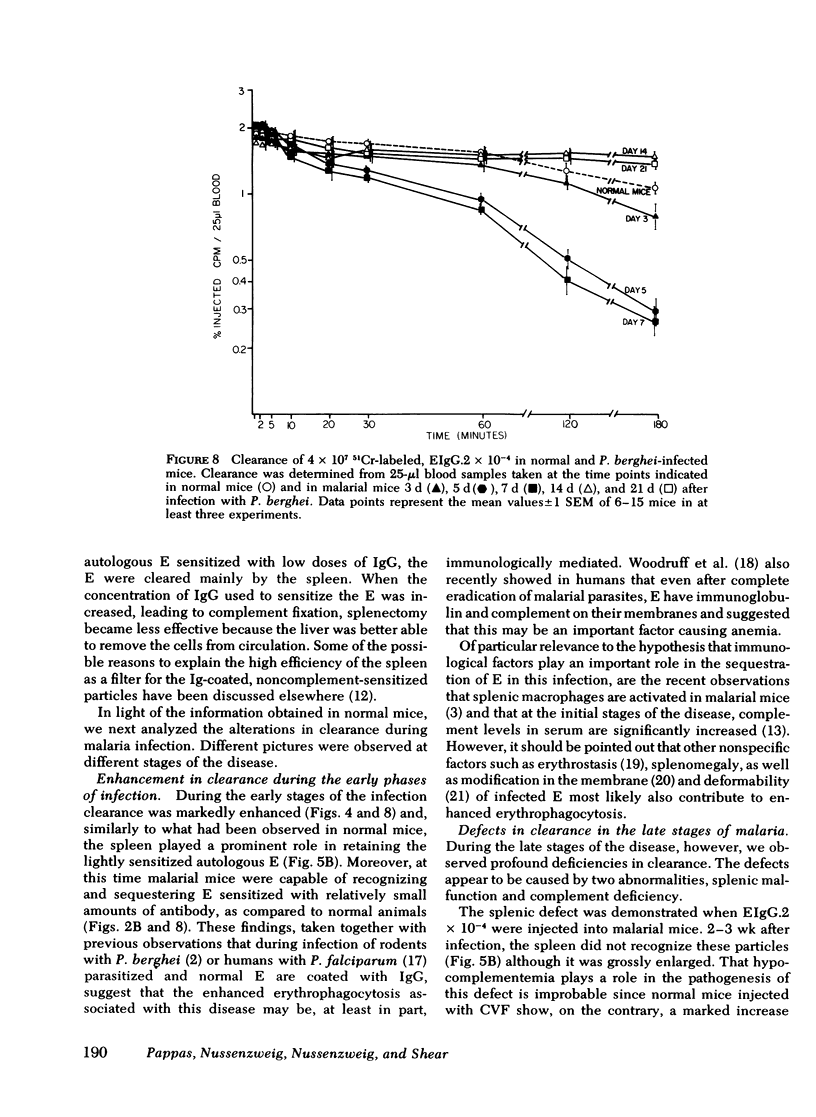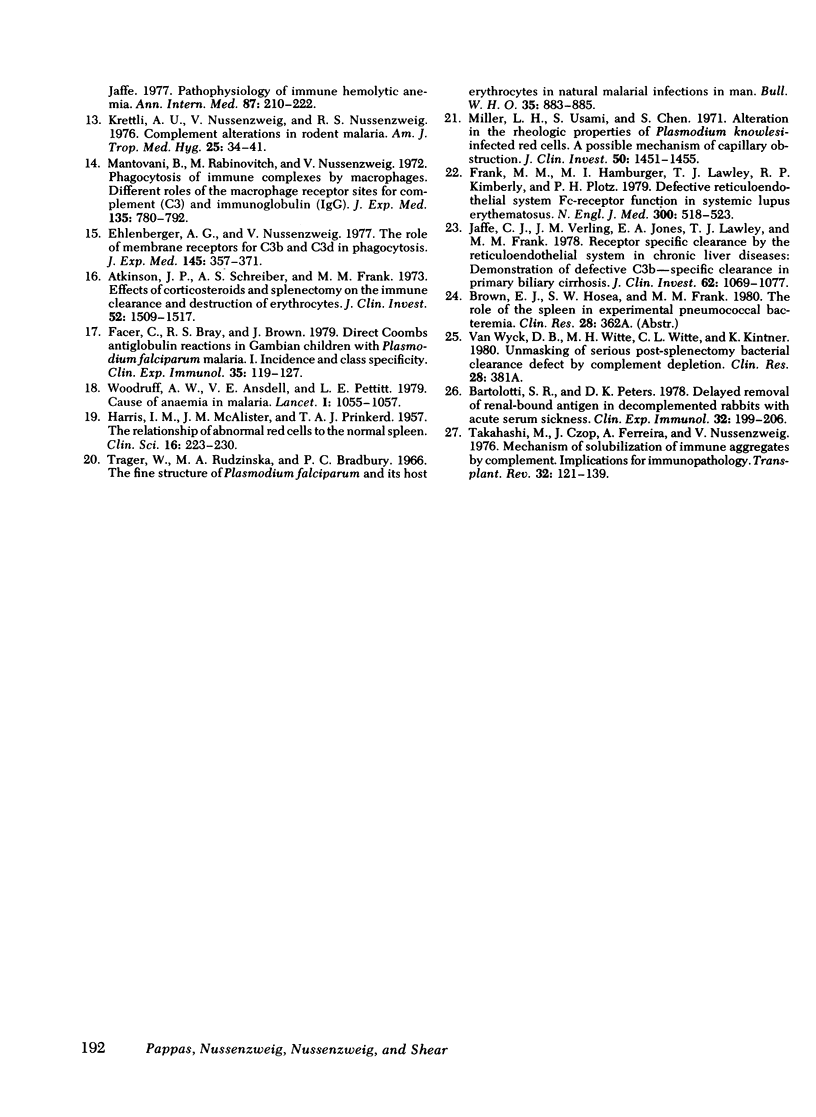Abstract
We investigated the ability of malaria-infected and normal mice to clear particulate immune complexes consisting of autologous erythrocytes sensitized with either IgG or complement.
Normal mice rapidly clear autologous erythrocytes optimally sensitized with IgG and the liver plays a major role in their sequestration. Clearance of optimally sensitized erythrocytes is complement-dependent because cobra venom factor-treated, normal mice failed to clear these cells rapidly, unless they had been pre-treated with fresh mouse serum.
In the initial phase of Plasmodium berghei infection, clearance of the optimally sensitized erythrocytes was markedly increased over that observed in normal mice. 2 wk after infection, however, clearance was minimal. This defect was most likely the consequence of the hypocomplementemia observed at this stage of infection since sensitized erythrocytes were removed rapidly from the blood if they had been coated with C3 in vitro before injection into malarial mice.
The functional activity of the complement receptors of phagocytic cells was assayed in malarial mice by the injection of autologous erythrocytes coated with C3 and C4 in the absence of antibody. The complement-coated erythrocytes were rapidly removed from the blood, accumulated in the liver, and then gradually returned to the circulation. Similar patterns were observed in normal animals, but the degree of clearance was considerably higher in the malarial mice late in infection. It appears, therefore, that complement receptors remain functional throughout the infection.
Erythrocytes suboptimally sensitized with IgG were cleared minimally by normal mice. This clearance was not complement-dependent and was mediated mainly by the spleen. During malaria, clearance of these particles was initially enhanced but later it was abolished.
The association of hypocomplementemia with a major splenic defect in clearance late in malaria infection may explain the accumulation of immune complexes in pathological sites observed in this disease.
Full text
PDF









Selected References
These references are in PubMed. This may not be the complete list of references from this article.
- Atkinson J. P., Schreiber A. D., Frank M. M. Effects of corticosteroids and splenectomy on the immune clearance and destruction of erythrocytes. J Clin Invest. 1973 Jun;52(6):1509–1517. doi: 10.1172/JCI107325. [DOI] [PMC free article] [PubMed] [Google Scholar]
- Bartolotti S. R., Peters D. K. Delayed removal of renal-bound antigen in decomplemented rabbits with acute serum sickness. Clin Exp Immunol. 1978 May;32(2):199–206. [PMC free article] [PubMed] [Google Scholar]
- Bianco C., Patrick R., Nussenzweig V. A population of lymphocytes bearing a membrane receptor for antigen-antibody-complement complexes. I. Separation and characterization. J Exp Med. 1970 Oct 1;132(4):702–720. doi: 10.1084/jem.132.4.702. [DOI] [PMC free article] [PubMed] [Google Scholar]
- Ehlenberger A. G., Nussenzweig V. The role of membrane receptors for C3b and C3d in phagocytosis. J Exp Med. 1977 Feb 1;145(2):357–371. doi: 10.1084/jem.145.2.357. [DOI] [PMC free article] [PubMed] [Google Scholar]
- Facer C. A., Bray R. S., Brown J. Direct Coombs antiglobulin reactions in Gambian children with Plasmodium falciparum malaria. I. Incidence and class specificity. Clin Exp Immunol. 1979 Jan;35(1):119–127. [PMC free article] [PubMed] [Google Scholar]
- Ferreira A., Nussenzweig V. Mouse C4 (Ss): three-step purification of its C4c fragment and production of a monospecific antiserum. J Immunol. 1979 Feb;122(2):490–493. [PubMed] [Google Scholar]
- Frank M. M., Hamburger M. I., Lawley T. J., Kimberly R. P., Plotz P. H. Defective reticuloendothelial system Fc-receptor function in systemic lupus erythematosus. N Engl J Med. 1979 Mar 8;300(10):518–523. doi: 10.1056/NEJM197903083001002. [DOI] [PubMed] [Google Scholar]
- HARRIS I. M., MCALISTER J. M., PRANKERD T. A. The relationship of abnormal red cells to the normal spleen. Clin Sci. 1957 May;16(2):223–230. [PubMed] [Google Scholar]
- Hartmann R. C., Jenkins D. E. The "sugar-water" test for paroxysmal nocturnal hemoglobinuria. N Engl J Med. 1966 Jul 21;275(3):155–157. doi: 10.1056/NEJM196607212750308. [DOI] [PubMed] [Google Scholar]
- Jaffe C. J., Vierling J. M., Jones E. A., Lawley T. J., Frank M. M. Receptor specific clearance by the reticuloendothelial system in chronic liver diseases. Demonstration of defective C3b-specific clearance in primary biliary cirrhosis. J Clin Invest. 1978 Nov;62(5):1069–1077. doi: 10.1172/JCI109212. [DOI] [PMC free article] [PubMed] [Google Scholar]
- Krettli A. U., Nussenzweig V., Nussenzweig R. S. Complement alterations in rodent malaria. Am J Trop Med Hyg. 1976 Jan;25(1):34–41. doi: 10.4269/ajtmh.1976.25.34. [DOI] [PubMed] [Google Scholar]
- Lustig H. J., Nussenzweig V., Nussenzweig R. S. Erythrocyte membrane-associated immunoglobulins during malaria infection of mice. J Immunol. 1977 Jul;119(1):210–216. [PubMed] [Google Scholar]
- MARDINEY M. R., Jr, MUELLER-EBERHARD H. J. MOUSE BETA-1C-GLOBULIN: PRODUCTION OF ANTISERUM AND CHARACTERIZATION IN THE COMPLEMENT REACTION. J Immunol. 1965 Jun;94:877–882. [PubMed] [Google Scholar]
- Mantovani B., Rabinovitch M., Nussenzweig V. Phagocytosis of immune complexes by macrophages. Different roles of the macrophage receptor sites for complement (C3) and for immunoglobulin (IgG). J Exp Med. 1972 Apr 1;135(4):780–792. doi: 10.1084/jem.135.4.780. [DOI] [PMC free article] [PubMed] [Google Scholar]
- Miller L. H., Usami S., Chien S. Alteration in the rheologic properties of Plasmodium knowlesi--infected red cells. A possible mechanism for capillary obstruction. J Clin Invest. 1971 Jul;50(7):1451–1455. doi: 10.1172/JCI106629. [DOI] [PMC free article] [PubMed] [Google Scholar]
- NECHELES T. F., WEINSTEIN I. M., LEROY G. V. Radioactive sodium chromate for the study of survival of red blood cells. I. The effect of radioactive sodium chromate on red cells. J Lab Clin Med. 1953 Sep;42(3):358–367. [PubMed] [Google Scholar]
- NIH conference. Pathophysiology of immune hemolytic anemia. Ann Intern Med. 1977 Aug;87(2):210–222. doi: 10.7326/0003-4819-87-2-210. [DOI] [PubMed] [Google Scholar]
- Nelson R. A., Jr, Jensen J., Gigli I., Tamura N. Methods for the separation, purification and measurement of nine components of hemolytic complement in guinea-pig serum. Immunochemistry. 1966 Mar;3(2):111–135. doi: 10.1016/0019-2791(66)90292-8. [DOI] [PubMed] [Google Scholar]
- Shear H. L., Nussenzweig R. S., Bianco C. Immune phagocytosis in murine malaria. J Exp Med. 1979 Jun 1;149(6):1288–1298. doi: 10.1084/jem.149.6.1288. [DOI] [PMC free article] [PubMed] [Google Scholar]
- Takahashi M., Czop J., Ferreira A., Nussenzweig V. Mechanism of solubilization of immune aggregates by complement. Implications for immunopathology. Transplant Rev. 1976;32:121–139. doi: 10.1111/j.1600-065x.1976.tb00231.x. [DOI] [PubMed] [Google Scholar]
- Trager W., Rudzinska M. A., Bradbury P. C. The fine structure of Plasmodium falciparum and its host erythrocytes in natural malarial infections in man. Bull World Health Organ. 1966;35(6):883–885. [PMC free article] [PubMed] [Google Scholar]
- Vanderberg J. P., Nussenzweig R. S., Most H. Further studies on the Plasmodium berghei-Anopheles stephensi--rodent system of mammalian malaria. J Parasitol. 1968 Oct;54(5):1009–1016. [PubMed] [Google Scholar]
- Woodruff A. W., Ansdell V. E., Pettitt L. E. Cause of anaemia in malaria. Lancet. 1979 May 19;1(8125):1055–1057. doi: 10.1016/s0140-6736(79)92952-0. [DOI] [PubMed] [Google Scholar]


